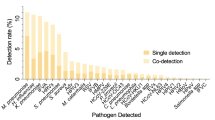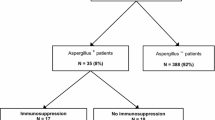Abstract
Purpose
Community-acquired pneumonia (CAP) is a leading cause of adult mortality worldwide and poses a significant global burden. Previous studies have indicated a tendency for viral pneumonia, particularly severe influenza virus pneumonia, to be complicated by Aspergillus superinfection. However, the clinical features and prognostic implications of Aspergillus detection in early-onset viral CAP remain unclear.
Methods
We conducted a prospective multicenter observational cohort study in China involving CAP patients. Adult patients with CAP from six hospitals were enrolled between January 2017 and October 2018. Within 72 h of admission, lower respiratory tract specimens, including sputum and alveolar lavage fluid, were collected. Comprehensive pathogenic testing, utilizing molecular biology techniques, was performed on the collected specimens, encompassing bacteria, atypical pathogens, viruses, and fungi. Patient clinical data were collected through a unified electronic medical record website system.
Results
A total of 382 adult CAP patients were included in the study. The viral detection rate was 38% (145/382), with Aspergillus identified in 11.0% (16/145) of viral CAP cases. Mortality among Aspergillus-positive patients was significantly higher (25%, 4/16) compared to Aspergillus-negative patients (5.4%, 7/129) in viral CAP (P = 0.021). Multivariable logistic regression models demonstrated that the presence of Aspergillus at admission might increase the mortality risk in viral CAP [OR (95%CI) = 7.34 (0.92–58.65), P = 0.06]. Furthermore, Aspergillus-positive patients exhibited a significantly lower lymphocyte count than Aspergillus-negative patients (P = 0.047).
Conclusion
Positive detection of Aspergillus in lower respiratory tract specimens might be associated with higher mortality in early-onset viral CAP.
Trial Registration
ClinicalTrials.gov, NCT03093220. Registered retrospectively on 28 March 2017.




Similar content being viewed by others
References
Musher DM, Thorner AR (2014) Community-acquired pneumonia. N Engl J Med 371:1619–1628. https://doi.org/10.1056/NEJMra1312885
Beović B, Bonac B, Kese D et al (2003) Aetiology and clinical presentation of mild community-acquired bacterial pneumonia. Eur J Clin Microbiol Infect Dis 22:584–591. https://doi.org/10.1007/s10096-003-0997-0
Jain S, Self WH, Wunderink RG et al (2015) Community-Acquired Pneumonia requiring hospitalization among U.S. adults. N Engl J Med 373:415–427. https://doi.org/10.1056/NEJMoa1500245
Bautista E, Chotpitayasunondh T, Gao Z et al (2010) Clinical aspects of pandemic 2009 influenza A (H1N1) virus infection. N Engl J Med 362:1708–1719. https://doi.org/10.1056/NEJMra1000449
Grimaldi D, Llitjos JF, Pène F (2014) Post-infectious immune suppression: a new paradigm of severe infections. Med Mal Infect 44:455–463. https://doi.org/10.1016/j.medmal.2014.07.017
Koch RM, Kox M, De Jonge MI et al (2017) Patterns in bacterial- and Viral-Induced Immunosuppression and secondary infections in the ICU. Shock 47:5–12. https://doi.org/10.1097/shk.0000000000000731
Beumer MC, Koch RM, Van Beuningen D et al (2019) Influenza virus and factors that are associated with ICU admission, pulmonary co-infections and ICU mortality. J Crit Care 50:59–65. https://doi.org/10.1016/j.jcrc.2018.11.013
Crotty MP, Meyers S, Hampton N et al (2015) Epidemiology, co-infections, and outcomes of viral pneumonia in adults: an Observational Cohort Study. Med (Baltim) 94:e2332. https://doi.org/10.1097/md.0000000000002332
Radovanovic D, Sotgiu G, Jankovic M et al (2019) An international perspective on hospitalized patients with viral community-acquired pneumonia. Eur J Intern Med 60:54–70. https://doi.org/10.1016/j.ejim.2018.10.020
Van De Veerdonk FL, Kolwijck E, Lestrade PP et al (2017) Influenza-Associated Aspergillosis in critically ill patients. Am J Respir Crit Care Med 196:524–527. https://doi.org/10.1164/rccm.201612-2540LE
Sharma A, Mishra T, Kumar N et al (2020) Influenza-Associated Aspergillosis: Nationwide Trends, Predictors and Outcomes from 2005 to 2014. Chest 158:1857–1866. https://doi.org/10.1016/j.chest.2020.06.010
Crum-Cianflone NF (2016) Invasive aspergillosis Associated with severe influenza infections. Open Forum Infect Dis 3:ofw171. https://doi.org/10.1093/ofid/ofw171
Waldeck F, Boroli F, Suh N et al (2020) Influenza-associated aspergillosis in critically-ill patients-a retrospective bicentric cohort study. Eur J Clin Microbiol Infect Dis 39:1915–1923. https://doi.org/10.1007/s10096-020-03923-7
Wauters J, Baar I, Meersseman P et al (2012) Invasive pulmonary aspergillosis is a frequent complication of critically ill H1N1 patients: a retrospective study. Intensive Care Med 38:1761–1768. https://doi.org/10.1007/s00134-012-2673-2
Schauwvlieghe A, Rijnders BJA, Philips N et al (2018) Invasive aspergillosis in patients admitted to the intensive care unit with severe influenza: a retrospective cohort study. Lancet Respir Med 6:782–792. https://doi.org/10.1016/s2213-2600(18)30274-1
Bartoletti M, Pascale R, Cricca M et al (2021) Epidemiology of Invasive Pulmonary Aspergillosis among intubated patients with COVID-19: a prospective study. Clin Infect Dis 73:e3606–e14. https://doi.org/10.1093/cid/ciaa1065
Seyedjavadi SS, Bagheri P, Nasiri MJ et al (2022) Fungal infection in co-infected patients with COVID-19: an overview of Case Reports/Case Series and systematic review. Front Microbiol 13:888452. https://doi.org/10.3389/fmicb.2022.888452
Mandell LA, Wunderink RG, Anzueto A et al (2007) Infectious Diseases Society of America/American thoracic society consensus guidelines on the management of community-acquired pneumonia in adults. Clin Infect Dis 44(Suppl 2):S27–72. https://doi.org/10.1086/511159
Lim WS, Van Der Eerden MM, Laing R et al (2003) Defining community acquired pneumonia severity on presentation to hospital: an international derivation and validation study. Thorax 58:377–382
Fine MJ, Auble TE, Yealy DM et al (1997) A prediction rule to identify low-risk patients with community-acquired pneumonia. N Engl J Med 336:243–250. https://doi.org/10.1056/nejm199701233360402
Zhang G, Zheng G, Zhang Y et al (2018) Evaluation of a micro/nanofluidic chip platform for the high-throughput detection of bacteria and their antibiotic resistance genes in post-neurosurgical meningitis. Int J Infect Dis 70:115–120. https://doi.org/10.1016/j.ijid.2018.03.012
Zhou F, Wang Y, Liu Y et al (2019) Disease severity and clinical outcomes of community-acquired pneumonia caused by non-influenza respiratory viruses in adults: a multicentre prospective registry study from the CAP-China Network. Eur Respir J 54. https://doi.org/10.1183/13993003.02406-2018
Costa C, Sidoti F, Saldan A et al (2012) Clinical impact of HSV-1 detection in the lower respiratory tract from hospitalized adult patients. Clin Microbiol Infect 18:E305–E307. https://doi.org/10.1111/j.1469-0691.2012.03882.x
Chen L, Han X, Li Y et al (2020) Invasive pulmonary aspergillosis in immunocompetent patients hospitalised with influenza A-related pneumonia: a multicenter retrospective study. BMC Pulm Med 20:239. https://doi.org/10.1186/s12890-020-01257-w
Ku YH, Chan KS, Yang CC et al (2017) Higher mortality of severe influenza patients with probable aspergillosis than those with and without other coinfections. J Formos Med Assoc 116:660–670. https://doi.org/10.1016/j.jfma.2017.06.002
White PL, Dhillon R, Cordey A et al (2021) A National Strategy to Diagnose Coronavirus Disease 2019-Associated Invasive Fungal Disease in the Intensive Care Unit. Clin Infect Dis 73:e1634–e44. https://doi.org/10.1093/cid/ciaa1298
Cadena J, Thompson GR 3rd, Patterson TF (2021) Aspergillosis: epidemiology, diagnosis, and treatment. Infect Dis Clin North Am 35:415–434. https://doi.org/10.1016/j.idc.2021.03.008
Shi SJ, Li H, Liu M et al (2017) Mortality prediction to hospitalized patients with influenza pneumonia: PO(2) /FiO(2) combined lymphocyte count is the answer. Clin Respir J 11:352–360. https://doi.org/10.1111/crj.12346
Acknowledgements
The authors wish to thank staff members of the cooperating hospitals (Fujian Provincial Hospital, Fuzhou, China; West China Hospital, Chengdu, China; Second Hospital of Jilin University, Changchun, China; Shanghai Pulmonary Hospital, Shanghai, China; Tibet Autonomous Region People’s Hospital, Lasa, China) for assistance with samples and clinical data collection.
Funding
The work was funded by grants from the National Key Research and Development Program “Precision Medicine Research” from the Ministry of Science and Technology of China (2016YFC0903800), National Natural Science Foundation of China (8200011769) and Peking University People’s Hospital Research and Development Funds (RDJP2022-43).
Author information
Authors and Affiliations
Contributions
All authors contributed to the study conception and design. Material preparation, data collection and analysis were performed by Lu Yin, Ying Zhang, Wentao Ni, Yali Zheng and Qiongzhen Luo. The project management was performed by Lili Zhao. The first draft of the manuscript was written by Lu Yin, Ying Zhang and Wentao Ni, and all authors commented on previous versions of the manuscript. All authors reviewed and approved the final manuscript.
Corresponding authors
Ethics declarations
Ethics Approval
This study was performed in line with the principles of the Declaration of Helsinki. This study was approved by the Institutional Review Board of the Peking University People’s Hospital (No. 2011-83).
Consent to Participate
Informed Consent was obtained from all individual participants included in the study.
Consent to Publish
None to Declare.
Competing Interests
The authors have no relevant financial or non-financial interests to disclose.
Additional information
Publisher’s Note
Springer Nature remains neutral with regard to jurisdictional claims in published maps and institutional affiliations.
Electronic Supplementary Material
Below is the link to the electronic supplementary material.
Rights and permissions
Springer Nature or its licensor (e.g. a society or other partner) holds exclusive rights to this article under a publishing agreement with the author(s) or other rightsholder(s); author self-archiving of the accepted manuscript version of this article is solely governed by the terms of such publishing agreement and applicable law.
About this article
Cite this article
Yin, L., Zhang, Y., Zheng, Y. et al. Early Detection of Aspergillus Species in Lower Respiratory Tract is Associated with Higher Mortality in Viral Community-Acquired Pneumonia: A Multicenter Prospective Cohort Study in China. Lung 201, 387–396 (2023). https://doi.org/10.1007/s00408-023-00638-2
Received:
Accepted:
Published:
Issue Date:
DOI: https://doi.org/10.1007/s00408-023-00638-2




